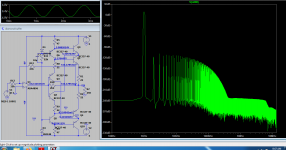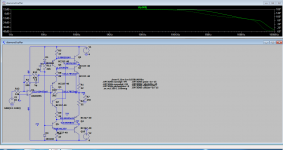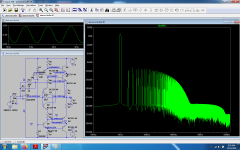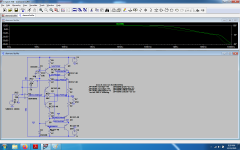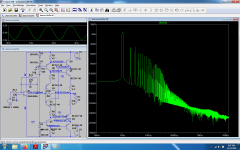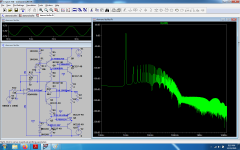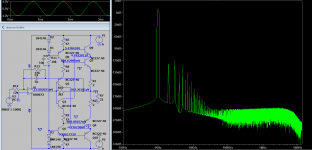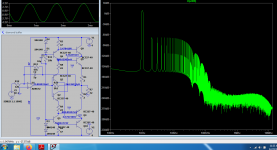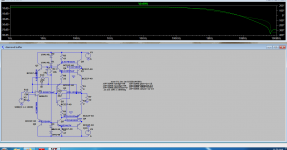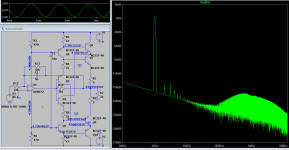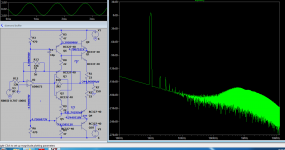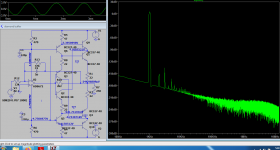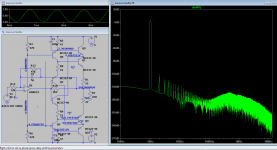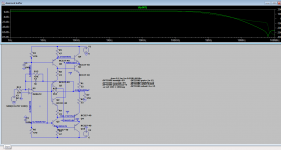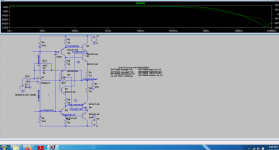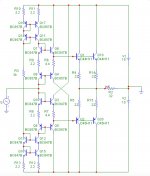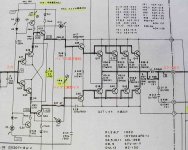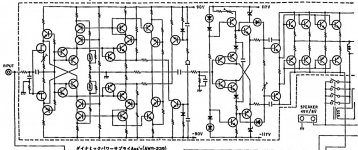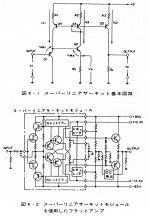The simpler , the better, just closer to clipping :
Attachments
Last edited:
just realized i have enough lm6152 so 3v supply operation with some further simplification might be possible.
indeed...it looks a bit better being more simmetrical, probably due to lower input bias current, yet it's not RRO so you won't go too low with the supply rails.a bit slower so it needs a bit of compensation around 1 megHz not like the others which are ringing around 10 meg , but 5pF is more effective here as the opamp is better suited for audio.How about Ad8672? Its specifically for nested feedback duties
Attachments
Simplified even more for useful signal using the op-amp idle current to set Q6, Q5 current and also the level of feed-forward signal with R3, R6 giving more current to the lower diamond buffer when needed.C1 could probably be 100...220 uf , but simulation takes way too much for higher values than 10uf...
Attachments
Last edited:
Shouldnt there be decouplers to gnd after r3 r6 also or does it not care?
Edit: i see how the signal is bootstrapped by q5 and 6. Very clever! Im really wanting to build this
Edit: i see how the signal is bootstrapped by q5 and 6. Very clever! Im really wanting to build this
I'd rather try 220uF for C1 ...even though i can't sim it this century.Shouldnt there be decouplers to gnd after r3 r6 also or does it not care?
Attachments
What does other measurements look like? Maybe r3 c1 is forming an aggressive lpf
Attachments
I cant really tell. I hope its good.
Looking back at timS' circuit i realized i have another, and probably the best option for thermal coupling which is to use to92s for the input and the output, arrange them so that the flat sides face eachother and voila, shrinkwrap coupling. Being a linestage buffer i wont need more than 1 pair of output so this is ideal.
Ofcourse being a notice i dont know whether q7 and 6 should be complimentary types to q9 and q4. If not i can use bcv61/62 for all the outer current mirrors (6 total) for best performance
Looking back at timS' circuit i realized i have another, and probably the best option for thermal coupling which is to use to92s for the input and the output, arrange them so that the flat sides face eachother and voila, shrinkwrap coupling. Being a linestage buffer i wont need more than 1 pair of output so this is ideal.
Ofcourse being a notice i dont know whether q7 and 6 should be complimentary types to q9 and q4. If not i can use bcv61/62 for all the outer current mirrors (6 total) for best performance
Attachments
Honesly i don't see that pile of transistors getting you better results than a tpa6120 project...
Hey dont knock it until you try it. This one has that certain magic and thats compared to countless circuits ive already tried
the last magic i want on my 200 pounds headphones would be some dc voltage...some other guys might make the same argument for a few thousand dollars headphones...besides tpa6120 is magic enough for most people...I might be the guy that tried most of the commercial topologies that ever existed plus a few others that were never commercial , but never found an interest into magic smoke ....
Ah this is for linestage duty into a cap coupled amp. Id def loop an opamp around this buffer for headphones at which point we would not be having this troubleshoot 🙂
From anacdotes alone 6120 is very appealing but their pin arrangements turn me off. Its a nightmare if u want any high end configuration out of it. I did come up with an idea while typing this tho so ill def look at the chip some more. An internal diagram would be nice
From anacdotes alone 6120 is very appealing but their pin arrangements turn me off. Its a nightmare if u want any high end configuration out of it. I did come up with an idea while typing this tho so ill def look at the chip some more. An internal diagram would be nice
What do you mean? It has the most simmetrical arangement you coyoul could get for two channels...It's just a downgraded version of THS6012.Check its datasheet.You could buy THS6012 instead but that's not going to get you a better sound .They are made to work in the megahertz range...so you need a good pcb artwork but that's not something out of reach.And they are already the highest end chips on the market...You can buy high end circuits based on them in any shape and form from countless manufacturers...I have a friend that's using two of them in parallel on one channel to drive some Fostex based horns for more than a decade now...From anacdotes alone 6120 is very appealing but their pin arrangements turn me off. Its a nightmare if u want any high end configuration out of it.
Its precisely because their pinout is symmetrical you cant configure them for equal impedance traces for both channels and this issue is only exasperated if u decide to wrap them around the opamps because we now also have to cater to the non symmetry of the two opamps.
But this is kinda sematics. If you work the whole machine around the chip with floating pcb with twisted wires the symmetry of 6180 could be an asset. Im thinking in more of a production standpoint and also for my preamp which like most other gadgets have the transformers on one side and everything routed with traces. In that situation you will see that with pinouts like tpa6180's, the traces around it will eventually have to cross or stretch to an undesirable limit.
But this is kinda sematics. If you work the whole machine around the chip with floating pcb with twisted wires the symmetry of 6180 could be an asset. Im thinking in more of a production standpoint and also for my preamp which like most other gadgets have the transformers on one side and everything routed with traces. In that situation you will see that with pinouts like tpa6180's, the traces around it will eventually have to cross or stretch to an undesirable limit.
I'm not going to debate the capabilities of TPA6120 now...Everyone in the industry used them for their best headphones amplifiers including NEVE...If Neve is wrong, everyone is wrong.
This buffer yields better distortion performance and wider bandwidth than the diamond buffer.If used with silicon transistors you need to tame it by shunting the base-collector junction of the final transistors with almost 1nF capacitance to cancel some 10 Mhz oscillations.The buffer itself is at about -100db thd so no global feedback is needed.As i used germanium transistors i didn't need any BC compensation. https://www.diyaudio.com/community/threads/germanium-foundation-chapter1.381869/#post-6910850Hey dont knock it until you try it. This one has that certain magic and thats compared to countless circuits ive already tried
Very nice Dreamth. Ive currently made myself busy with the vssa topologyThis buffer yields better distortion performance and wider bandwidth than the diamond buffer.If used with silicon transistors you need to tame it by shunting the base-collector junction of the final transistors with almost 1nF capacitance to cancel some 10 Mhz oscillations.The buffer itself is at about -100db thd so no global feedback is needed.As i used germanium transistors i didn't need any BC compensation. https://www.diyaudio.com/community/threads/germanium-foundation-chapter1.381869/#post-6910850
https://www.diyaudio.com/community/threads/vssa-lateral-mosfet-amplifier.225747/page-175
Which has a lot of the characteristics of a diamond topology and soundwise.
- Home
- Amplifiers
- Solid State
- Improved Diamond Buffer Design
